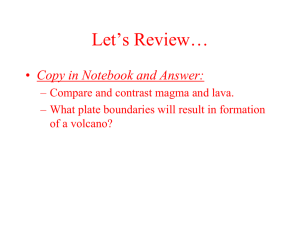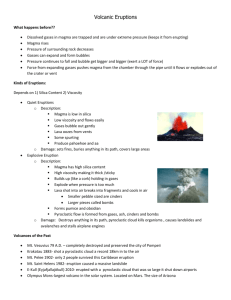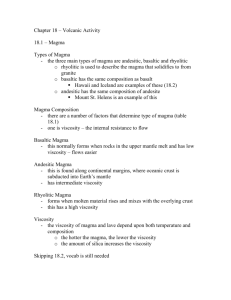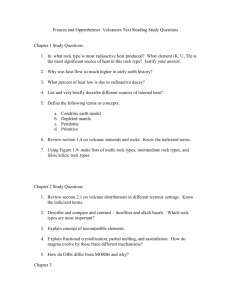97KB - NZQA
advertisement
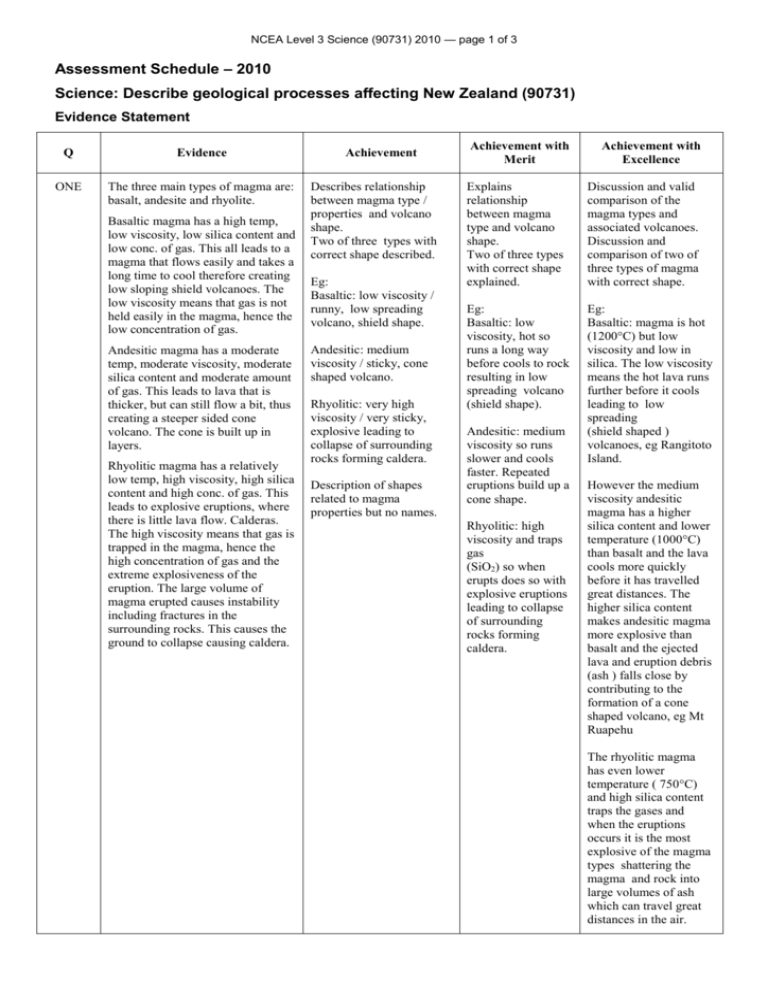
NCEA Level 3 Science (90731) 2010 — page 1 of 3 Assessment Schedule – 2010 Science: Describe geological processes affecting New Zealand (90731) Evidence Statement Q Evidence ONE The three main types of magma are: basalt, andesite and rhyolite. Basaltic magma has a high temp, low viscosity, low silica content and low conc. of gas. This all leads to a magma that flows easily and takes a long time to cool therefore creating low sloping shield volcanoes. The low viscosity means that gas is not held easily in the magma, hence the low concentration of gas. Andesitic magma has a moderate temp, moderate viscosity, moderate silica content and moderate amount of gas. This leads to lava that is thicker, but can still flow a bit, thus creating a steeper sided cone volcano. The cone is built up in layers. Rhyolitic magma has a relatively low temp, high viscosity, high silica content and high conc. of gas. This leads to explosive eruptions, where there is little lava flow. Calderas. The high viscosity means that gas is trapped in the magma, hence the high concentration of gas and the extreme explosiveness of the eruption. The large volume of magma erupted causes instability including fractures in the surrounding rocks. This causes the ground to collapse causing caldera. Achievement Describes relationship between magma type / properties and volcano shape. Two of three types with correct shape described. Eg: Basaltic: low viscosity / runny, low spreading volcano, shield shape. Andesitic: medium viscosity / sticky, cone shaped volcano. Rhyolitic: very high viscosity / very sticky, explosive leading to collapse of surrounding rocks forming caldera. Description of shapes related to magma properties but no names. Achievement with Merit Achievement with Excellence Explains relationship between magma type and volcano shape. Two of three types with correct shape explained. Discussion and valid comparison of the magma types and associated volcanoes. Discussion and comparison of two of three types of magma with correct shape. Eg: Basaltic: low viscosity, hot so runs a long way before cools to rock resulting in low spreading volcano (shield shape). Eg: Basaltic: magma is hot (1200°C) but low viscosity and low in silica. The low viscosity means the hot lava runs further before it cools leading to low spreading (shield shaped ) volcanoes, eg Rangitoto Island. Andesitic: medium viscosity so runs slower and cools faster. Repeated eruptions build up a cone shape. Rhyolitic: high viscosity and traps gas (SiO2) so when erupts does so with explosive eruptions leading to collapse of surrounding rocks forming caldera. However the medium viscosity andesitic magma has a higher silica content and lower temperature (1000°C) than basalt and the lava cools more quickly before it has travelled great distances. The higher silica content makes andesitic magma more explosive than basalt and the ejected lava and eruption debris (ash ) falls close by contributing to the formation of a cone shaped volcano, eg Mt Ruapehu The rhyolitic magma has even lower temperature ( 750°C) and high silica content traps the gases and when the eruptions occurs it is the most explosive of the magma types shattering the magma and rock into large volumes of ash which can travel great distances in the air. NCEA Level 3 Science (90731) 2010 — page 2 of 3 Often the whole magma volume is erupted so that the rock surrounding the magma chamber is weakened and fractures falling in on itself forming a caldera (depression) which sometimes fills with water, eg Lake Taupo. TWO In the North Island ,where the dense oceanic Pacific Plate (basaltic composition) subducts under the less dense continental Australian Plate, the Pacific Plate crust moves down into the mantle. When deep enough, the plate begins to melt and the molten material (magma) rises to the surface. If the magma finds a weakness in the Earth’s crust, it can move through it and erupt at the surface as volcanoes. Geothermal activity results from the underground waterways heating up, due to the close proximity of hot magma in the crust. This can result in geysers, fumaroles and geothermal hot pools and is particularly evident in the Taupo Volcanic Zone. Mountain building in the South Island of New Zealand is a result of the two continental plates moving towards each other and the continental crust is forced up creating mountains. Both the Pacific and Australian plates are continental in composition at this location and they are colliding at a convergent plate boundary Description of TWO geological features and the processes that produce them. Geothermal activity caused by subduction. Mountains are caused by two plates colliding. Subduction causes volcanoes. Subduction situation in North Island described. Explanation of TWO geological features linked to the tectonic processes. In North Island Subduction of the dense oceanic Pacific Plate causes crust to be taken down to a depth where it melts to magma and can rise to surface through cracks forming volcanoes. Water near / in contact with hot magma / rocks in the crust heats up and leads to the geothermal features (hot pools, fumaroles, geysers). For Southern Alps – the Pacific and Australian plates are the same composition, so no subduction occurs. They collide at the convergent plate boundary and buckle up and form mountains. Composition of magma giving rise to geothermal activity / volcanoes and mountain building explained. Discussion of the relative movement of the two plates, and comparison of the two geological features that result. NCEA Level 3 Science (90731) 2010 — page 3 of 3 THREE P and S waves have different properties: P waves are longitudinal waves that can travel through liquids and solids at approx. 7 km s–1. S waves are transverse waves that can only travel through solids. They travel at approx. 4 km s–1. To work out the internal structure of the Earth, scientists have used large earthquakes that have been measured around the Earth. They look at whether the seismometers pick up both P and S waves. It was found that at some sites both were measured and at others only the P waves were measured. This data leads scientist to hypothesis that the internal structure of the Earth must contain an area of liquid / molten rock. Description and P and S waves properties. P, primary, fast longitudinal (description of) waves, travel (and refract) through both solids and liquids . S, secondary, slower transverse (description of) waves, travel only through solids. Explanation of internal structure of the earth in terms of wave motion. Discussion of how the properties of P and S waves are used to find the internal structure of the earth. P waves are bent / refract at boundaries of the layers within the Earth. S waves cannot be felt at all places on the earth (shadows). http: / / web.ics.purdue.edu / ~braile / edumod / journey / journey.htm Judgement Statement Achievement Achievement with Merit Achievement with Excellence 2A 1M+1A OR 1E+1A 1E+1M



